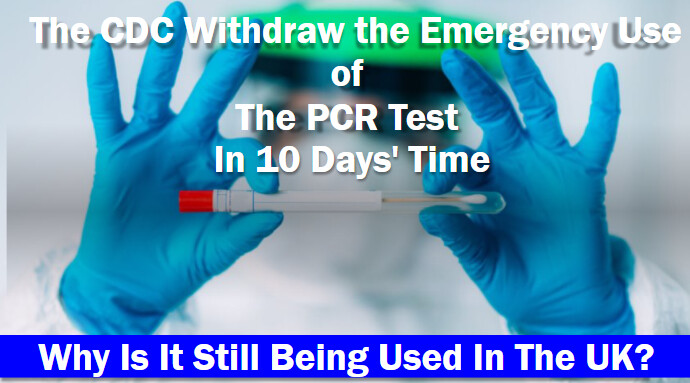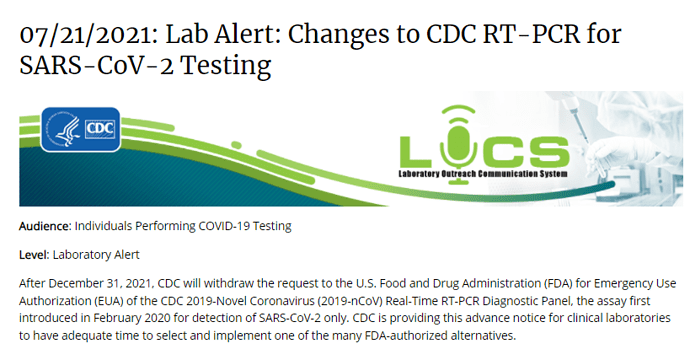Back in July 2021, The Centers for Disease Control and Prevention (CDC) announced that its PCR test has failed its full review and will have its Emergency Use Authorization revoked.
The Innova SARS-CoV-2 Antigen Rapid Qualitative Test, the CDC’s benchmark COVID diagnostic testing system, will be withdrawn for Emergency Use by the end of 2021 due to an inordinate frequency of false-positive and negative results.
“The FDA has identified this as a Class I recall, the most serious type of recall. Use of these devices may cause serious injuries or death,” the FDA stated on its website.
“After December 31, 2021, CDC will withdraw the request to the U.S. Food and Drug Administration (FDA) for Emergency Use Authorization (EUA) of the CDC 2019-Novel Coronavirus (2019-nCoV) Real-Time RT-PCR Diagnostic Panel, the assay first introduced in February 2020 for detection of SARS-CoV-2 only”.
The FDA goes on to explain the risks associated with false positives and negatives:
False-negative results may lead to delayed diagnosis or inappropriate treatment of SARS-CoV-2, which may cause patient harm including serious illness and death. False-negative results can also lead to further spread of the SARS-CoV-2 virus, including when presumed negative patients are grouped into cohorts in health care, long-term care, and other facilities based on false test results.
False-positive results could lead to a delay in the correct diagnosis and the initiation of an appropriate treatment for the actual cause of patient illness, which could be another life-threatening disease that is not SARS-CoV-2. False-positive results could also lead to further spread of the SARS-CoV-2 virus when presumed positive patients are grouped into cohorts based on false test results
Although the CDC was also a distributor of the RT-PCR Diagnostic Panel they advised that from September 30, 2021, they would no longer happen and that laboratories should transition away from the Diagnostic Panel by the end of 2021. Why would the CDC wait until the end of 2021 to cease the use of the RT-PCR Test.
The Novel Coronavirus
We are now almost at the second anniversary of the commencement of the governments across the globe terrorising their own people by claiming that there was a deadly new virus due to an initial 44 “cases” of pneumonia with unknown aetiology being discovered.
However, this was a virus that was so deadly, but we had to be tested for it to see if we had it or not.
“CDC is providing this advance notice for clinical laboratories to have adequate time to select and implement one of the many FDA-authorized alternatives”.
The RT PCR DebutThis began after a “public health emergency of international concern” (PHEIC) which was declared by the WHO Director-General Tedros Adhanom Ghebreyesus. An “emergency” situation was created despite the fact that there were a reported 170 deaths, which with a global population of over seven and three-quarters of a billion people (7,794,798,739) the number was relatively minuscule**.**
Not to mention the fact that 99% of the “cases” and 170 deaths which were all in China, were deemed to have been from a novel virus that had not been proven to exist, as it had not been isolated.
The Increase of Cases
A week or so before the WHO declaration of the PHEIC on January 23, 2020, a paper now referred to as the Corman Drosten paper had appeared on the WHO’s website (13th and 17th January 2020) from the scientific journal Eurosurveillance.
The authors of the published paper were Dr. Christian Drosten, and several of his colleagues from the Berlin Virology Institute, and the head of a biotech company, TIB Molbiol Syntheselabor GmbH, claimed to have developed the first effective test for detecting whether someone is infected with the novel coronavirus.
Despite the fact that the authors had acknowledged that they had designed the test “without having virus material available” The RT PCR test was to enter centre stage, enabling the statistics or “cases” to align with the declaration from the WHO resulting in the total number of cases increasing to 9,826.64 by the very next day.
The RT PCR Test Flaws
However, in November 2020 the Cornan Drosten paper which had been the basis for the widespread use of the PCR test had been reviewed by a group of scientists, Pieter Borger, Rajesh Kumar Malhotra, and Michael Yeadon et al.
The group of scientists and researchers concluded that the “external peer review of the RT PCR test to detect SARS-CoV-2” reveals 10 major scientific flaws at the molecular and methodological level.”
Just as the CDC had found, these flaws were consequences for false-positive results according to the scientists.
Vaccinated With A PCR Test-Swab In The Nose

